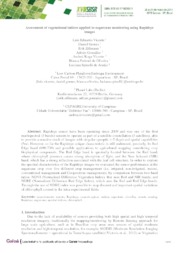Assessment of vegetational indices applied to sugarcane monitoring using Rapideye images.
Assessment of vegetational indices applied to sugarcane monitoring using Rapideye images.
Author(s): VICENTE, L. E.; LOEBMANN, D. G. dos S. W.; ZILLMANN, E.; GONZALEZ, A.; VICENTE, A. K.; OLIVEIRA, B. P. de; ARAUJO, L. S. de
Summary: Rapideye sensor have been operating since 2009 and was one of the first multispectral (5 bands) sensors to operate as part of a satellite constellation (5 satellites), able to provide a massive stock of images with singular synoptic (~5 days) and spatial capabilities (5m). However, so far the Rapideye unique characteristic is still underused, precisely, its Red Edge band (690-730) and possible applications to agricultural mapping considering crop biophysical compounds. The Red Edge band is spectrally located between the Red band, where chlorophyll presence causes strong absorption of light, and the Near Infrared (NIR) band, which has a strong reflection associated with the leaf cell structure. In rder to explore the spectral characteristics of the Rapideye images we evaluated the sensor performance at the sugarcane crop over five different crop anagement (i.e. irrigated, non-irrigated, meiosi, conventional management and Coopercitrus management), by comparison between two band ratios: NDVI (Normalized Difference Vegetation Index), that uses Red and NIR bands; and NDRE (Normalized Difference Red Edge Index), which uses the Red and Red Edge bands. Through the use of NDRE index was possible to map iscreet and important spatial variations of chlorophyll content in the intra experimental fields.
Publication year: 2017
Types of publication: Paper in annals and proceedings
Unit: Embrapa Environment
Observation
Some of Embrapa's publications are published as ePub files. To read them, use or download one of the following free software options to your computer or mobile device. Android: Google Play Books; IOS: iBooks; Windows and Linux: Calibre.
Access other publications
Access the Agricultural Research Database (BDPA) to consult Embrapa's full library collection and records.
Visit Embrapa Bookstore to purchase books and other publications sold by Embrapa.

